AEG-Electrolux GS18HTZDPB, FRT1S6ESB, FRT15G4BW User Manual
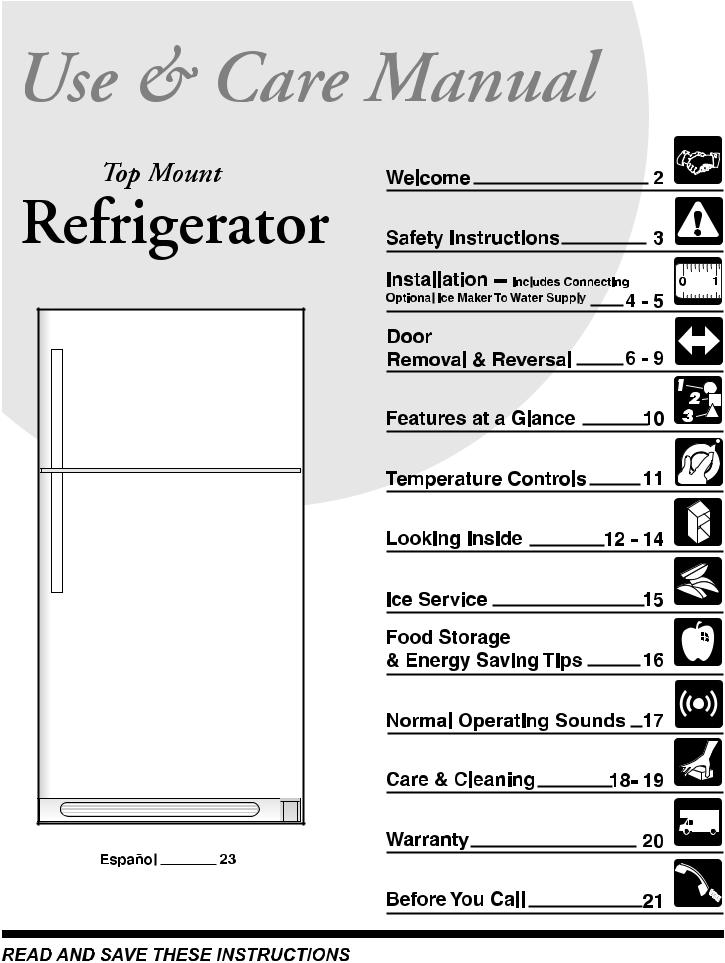
P/N 240400112 (0505)
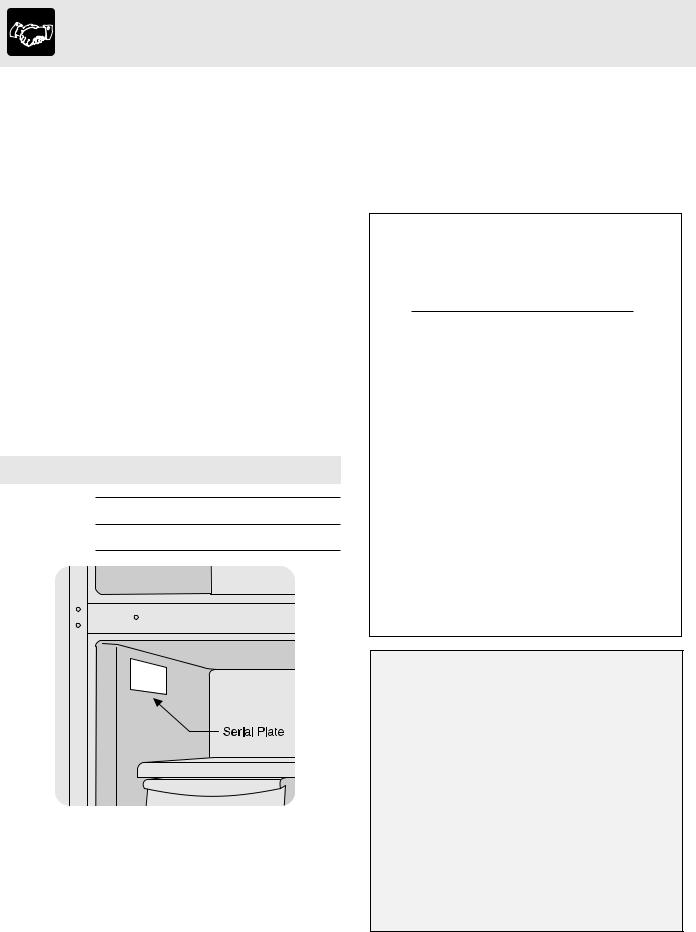
Welcome & Congratulations
Congratulations on your purchase of a new refrigerator! We here at Electrolux Home Products, Inc. are very proud of our product and we are completly committed to providing you with the best service possible. Your satisfaction is our #1 priority.
Please read this Use & Care Manual very carefully. It contains valuable information on how to properly maintain your new refrigerator.
We know you’ll enjoy your new refrigerator and ThankYou for choosing our product.We hope you consider us for future purchases.
PLEASE READ AND SAVE THESE INSTRUCTIONS
This Use & Care Manual provides specific operating instructions for your model. Use your refrigerator only as instructed in this manual. These instructions are not meant to cover every possible condition and situation that may occur. Common sense and caution must be practiced when installing, operating and maintaining any appliance.
Please record your model and serial numbers below for future reference.This information is found on your serial plate located inside the refrigerator compartment.
NOTE: Use only soap and water to clean serial plate.
Model Number:
Serial Number:
Purchase Date:
Questions? 1-800-944-9044
(United States)
1-866-213-9397
(Canada)
ExtendYourWarranty Protection
With An
Extended Service Contract
CALL 1-800-944-9044
To Enjoy These Benefits:
•Total freedom from repair bills so unexpected repairs won’t upset your budget.
•Fast, convenient toll-free service is just a phone call away.
•Top-quality repairs by factory-trained experts.
•Quick access to genuine replacement parts so you can rest assured your refrigerator is repaired with the proper components.
Please attach sales receipt here for future reference.
Please complete and mail in the Product Registration Card included with your refrigerator.
2
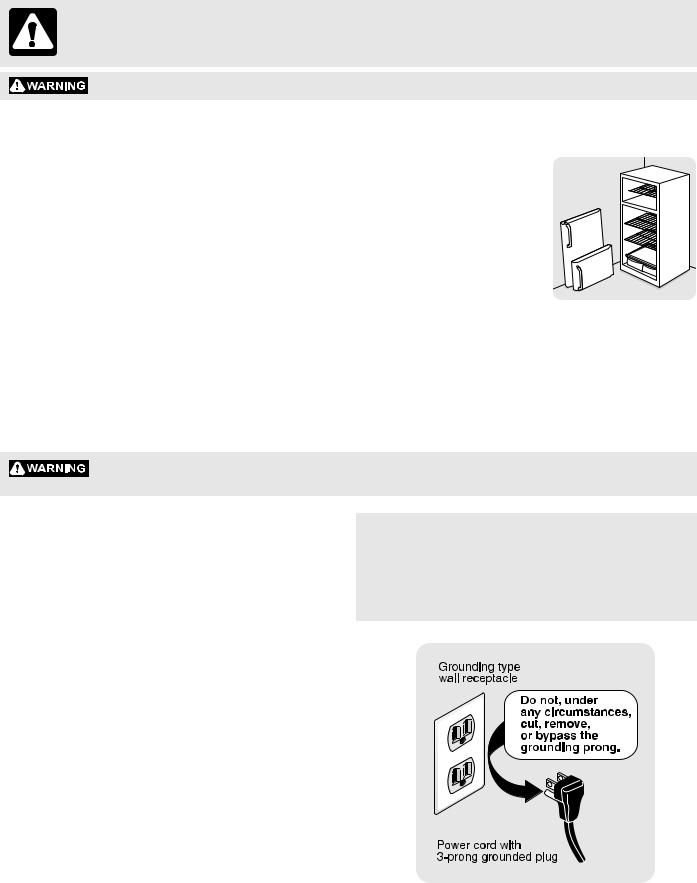
Important Safety Instructions
WARNING: Please Read All Instructions Before UsingThis Refrigerator.
FOR YOUR SAFETY
•Do not store or use gasoline, or other flammable liquids in the vicinity of this or any other appliance. Read product labels for warnings regarding flammability and other hazards.
•Do not operate the refrigerator in the presense of explosive fumes.
•Avoid contact with any moving parts of automatic ice maker.
•Remove all staples from the carton. Staples can cause severe cuts, and also destroy finishes if they come in contact with other appliances or furniture.
CHILD SAFETY
Destroy or recycle the carton, plastic bags, and any exterior wrapping material immediately after the refrigerator is unpacked. Children should NEVER use these items to play. Cartons covered with rugs, bedspreads, plastic sheets or stretch wrap may become airtight chambers, and can quickly cause suffocation.
PROPER DISPOSAL OF YOUR REFRIGERATOR OR FREEZER
Risk of child entrapment
Child entrapment and suffocation are not problems of the past. Junked or abondoned refrigerators or freezers are still dangerous – even if they will sit for “just a few days.” If you are getting rid of your old refrigerator or freezer, please follow the instructions below to help prevent accidents.
Before you throw away your old refrigerator/ freezer:
•Remove doors.
•Leave shelves in place so children may not easily climb inside.
•Have refrigerant removed by a qualified service technician.
These Guidelines Must Be Followed To Ensure That Safety Mechanisms In This Refrigerator Will Operate Properly.
ELECTRICAL INFORMATION
•The refrigerator must be plugged into its own dedicated 115 Volt, 60 Hz., AC only electric outlet.
The power cord of the appliance is equipped with a three-prong grounding plug for your protection against electrical shock hazards. It must be plugged directly into a properly grounded three-prong receptacle.The receptacle must be installed in accordance with local codes and ordinances. Consult a qualified electrician.
Do not use an extension cord or adapter plug.
•If the power cord is damaged, it should be replaced by the manufacturer, service technician or a qualified person to prevent any risk.
•Never unplug the refrigerator by pulling on the power cord. Always grip the plug firmly, and pull straight out from the receptacle to prevent damaging the power cord.
•Unplug the refrigerator before cleaning and before replacing a light bulb to avoid electrical shock.
•Performance may be affected if the voltage varies by 10% or more. Operating the refrigerator with insufficient power can damage the compressor. Such damage is not covered under your warranty.
•Do not plug the unit into an outlet controlled by a wall switch or pull cord to prevent the refrigerator from being turned off accidentally.
•Avoid connecting refrigerator to a Ground Fault Interruptor (GFI) circuit.
3
IMPORTANT: Turning the Freezer and Fresh Food Controls to “0” turns off the compressor and prevents your refrigerator from cooling, but does not disconnect the power to the light bulb and other electrical components.To turn off power to your refrigerator you must unplug the power cord from the wall outlet.

Installation
This Use & Care Manual provides specific operating instructions for your model. Use the refrigerator only as instructed in this Use & Care Manual. Before starting the refrigerator, follow these important first steps.
LOCATION
•Choose a place that is near a grounded electrical outlet. Do Not use an extension cord or an adapter plug.
•If possible, place the refrigerator out of direct sunlight and away from the range, dishwasher or other heat sources.
•The refrigerator must be installed on a floor that is level and strong enough to support a fully loaded refrigerator.
•Consider water supply availability for models equipped with an automatic ice maker.
INSTALLATION



 Do Not install the refrigerator where the temperature will drop below 55°F (13°C) or rise above 110°F (43°C).The compressor will not be able to maintain proper temperatures inside the refrigerator.
Do Not install the refrigerator where the temperature will drop below 55°F (13°C) or rise above 110°F (43°C).The compressor will not be able to maintain proper temperatures inside the refrigerator.



 Do Not block the toe grille on the lower front of your refrigerator. Sufficient air circulation is essential for the proper operation of your refrigerator.
Do Not block the toe grille on the lower front of your refrigerator. Sufficient air circulation is essential for the proper operation of your refrigerator.
Installation Clearances
•Allow the following clearances for ease of installation, proper air circulation, and plumbing and electrical connections:
Sides & Top --------------- |
3/8” |
Back ------------------------ |
1” |
NOTE: If you see black coils/tubing on the back of your refrigerator (air-cooled condenser) leave 3” clearance at top of refrigerator.
DOOR OPENING
NOTE: If your refrigerator is placed with the door hinge side against a wall, you may have to allow additional space so the door can be opened wider.
Your refrigerator should be positioned to allow easy access to a counter when removing food.To make this possible, the direction in which the doors open can be reversed. See Door Removal & Reversal Instructions on page 6.
LEVELING
All four corners of your refrigerator must rest firmly on a solid floor.Your refrigerator is equipped with adjustable front rollers or front leveling screws to help level your unit.
To LevelYour Refrigerator:
1. Remove toe grille.
2.Use flat-blade screwdriver or 3/8” socket wrench
to adjust front rollers. Use adjustable wrench to adjust leveling screws.
NOTE: Raise the front of the refrigerator enough so the doors close freely when opened halfway.The refrigerator should slope ¼” to ½” from front to back. Then level the refrigerator from side to side.
Adjustable Front Roller
Raise
Stationary Front Roller with Leveling Screw
4
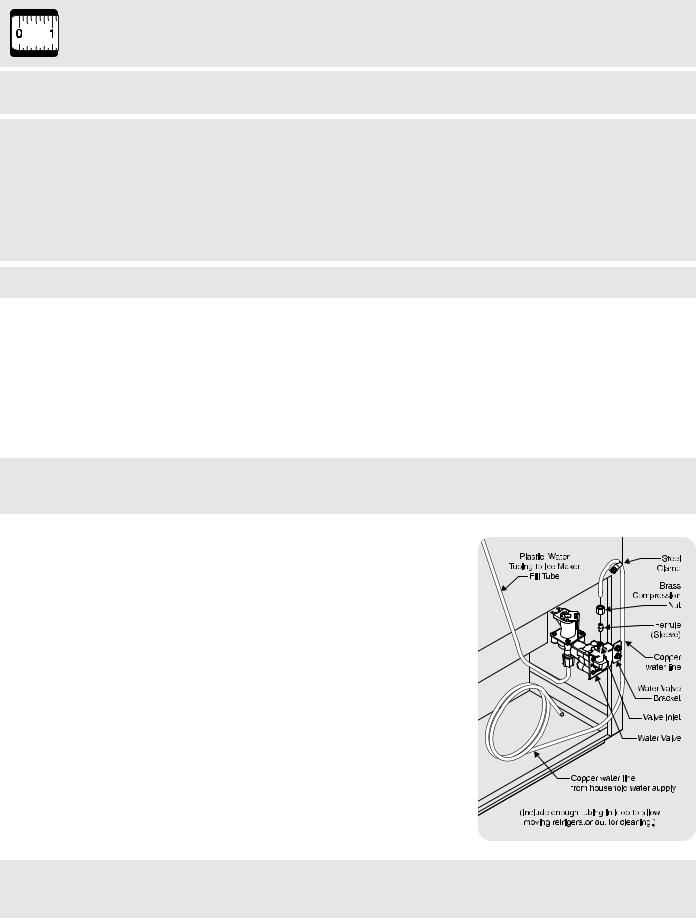
Installation - Connecting Optional Ice Maker To Water Supply




 To avoid electric shock, which can cause death or severe personal injury, disconnect the refrigerator from electrical power before connecting a water supply line to the refrigerator.
To avoid electric shock, which can cause death or severe personal injury, disconnect the refrigerator from electrical power before connecting a water supply line to the refrigerator.




 To Avoid Property Damage:
To Avoid Property Damage:
•Copper tubing is recommended for the water supply line.Water supply tubing made of ¼” plastic is not recommended since it greatly increases the potential for water leaks. Manufacturer will not be responsible for any damage if plastic tubing is used for supply line.
•DO NOT install water supply tubing in areas where temperatures fall below freezing.
•Chemicals from a malfunctioning softener can damage the ice maker. If the ice maker is connected to soft water, ensure that the softener is maintained and working properly.
IMPORTANT: Ensure that your water supply line connections comply with all local plumbing codes.
Before InstallingThe Water Supply Line,You Will Need
•BasicTools: adjustable wrench, flat-blade screwdriver, and PhillipsTM screwdriver
•Access to a household cold water line with water pressure between 30 and 120 psi.
•A water supply line made of ¼ inch (6.4 mm) OD, copper tubing.To determine the length of copper tubing needed, you will need to measure the distance from the ice maker inlet valve at the back of the refrigerator to your cold water pipe. Then add approximately 7 feet (2.1 meters), so the refrigerator can be moved out for cleaning (as shown).
•A shutoff valve to connect the water supply line to your household water system. DO NOT use a self-piercing type shutoff valve.
•A compression nut and ferrule (sleeve) for connecting the water supply line to the ice maker inlet valve.
NOTE: Water line kit number 5303917950, available from your appliance dealer at additional cost, contains 25 feet (7.6 meters) of ¼ inch OD copper tubing, a saddle type shutoff valve (nonpiercing), (2) ¼ inch brass compression nuts, (2) ferrules/sleeves, and instructions for installing a water supply line.
To Connect Water Supply Line To Ice Maker Inlet Valve
1. Disconnect refrigerator from electric power source.
2. Place end of water supply line into sink or bucket. Turn ON water supply and flush supply line until water is clear. Turn OFF water supply at shut off valve.
3. Unscrew plastic cap from water valve inlet and discard cap.
4. Slide brass compression nut, then ferrule (sleeve) onto water supply line, as shown.
5. Push water supply line into water valve inlet as far as it will go (¼ inch). Slide ferrule (sleeve) into valve inlet and finger tighten compression nut onto valve. Tighten another half turn with a wrench; DO NOT over tighten.
6. With steel clamp and screw, secure water supply line to rear panel of refrigerator as shown.
7.Coil excess water supply line (about 2½ turns) behind refrigerator as shown and arrange coils so they do not vibrate or wear against any other surface.
8. Turn ON water supply at shutoff valve and tighten any connections that leak.
9. Reconnect refrigerator to electrical power source.
10. To turn ice maker on, lower wire signal arm (see ice maker front cover for ON/ OFF position of arm).
IMPORTANT: It takes approximately 24 hours for the ice maker to begin producing ice. Air in new plumbing lines may cause ice maker to cycle two or three times before making a full tray of ice. New plumbing may cause ice to be discolored or have poor flavor. Discard ice made during the first 24 hours.
5
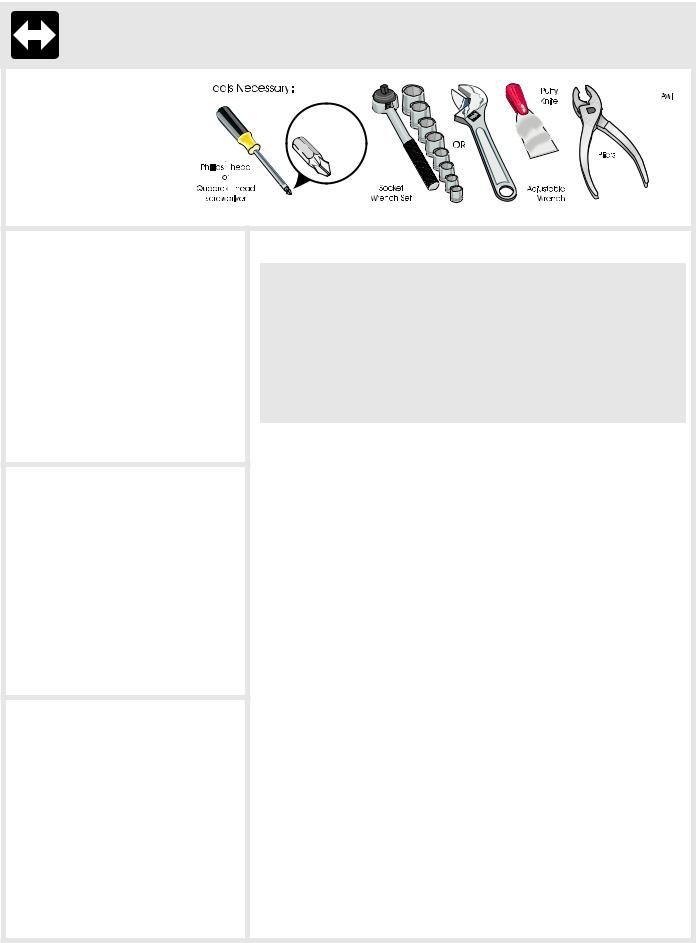
Door Removal and Reversal Instructions
DOOR REMOVAL AND REVERSAL INSTRUCTIONS:
NOTE: If you have stainless steel doors -- go to the Removing Stainless
Steel Doors and Handles Section on page 9.
NOTE: The direction in which your refrigerator doors open (door swing) can be reversed, from left to right or right to left, by moving the door hinges from one side to the other. Reversing the door swing should be performed by a qualified person.
IMPORTANT: Before you begin, turn the refrigerator temperature control to “0” and remove the electrical power cord from the wall outlet. Remove any food from door shelves.
1.Remove toe grille and top hinge cover.
2.Remove top hinge with 3/8” hex driver and lift freezer door off of center hinge pin. Set door aside.
3.Unscrew center hinge pin using adjustable wrench and save for
reassembly. Ensure plastic washer stays on hinge pin. 4. Lift refrigerator door off of bottom hinge and set aside.
5. Remove center hinge and shim by removing inside screw and loosening two outside screws enough to allow hinge and shim to slide out. Tighten screws.
6. Loosen two outside screws on opposite side of refrigerator, remove inside screw and install center hinge.
7. Remove two screws on bottom hinge with 3/8” socket wrench.
8. Install bottom hinge on opposite side with the two screws removed from step 7.
9. Unscrew bottom hinge pin using adjustable wrench. Move hinge pin to other hole in hinge and tighten with adjustable wrench.
10.Reverse door handles (see instructions on next page).
11.Move freezer and refrigerator door stops to opposite side. Before
starting screws, use an awl to puncture the foam.
12. Position refrigerator door onto bottom hinge pin and screw center hinge pin through center hinge into top of door. Close refrigerator door to help align hinge hole.
13. Tighten center hinge pin with adjustable wrench.
14. Remove cabinet and hinge hole plugs and move to opposite side. 15. Lower freezer door onto center hinge pin.
16.Close freezer door. Have an assistant lift up on opposite side of door while tightening screws to install top hinge.
17.Replace toe grille and top hinge cover.
18.Plug in electrical power cord and turn refrigerator temperature control to center position. Adjust setting as necessary.
6
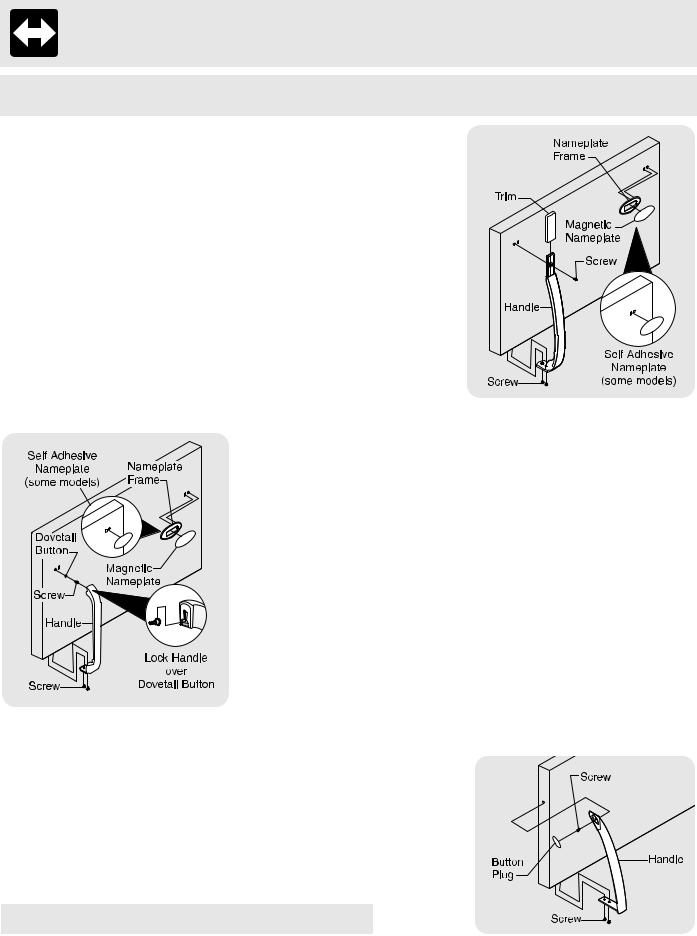
Door Removal and Reversal Instructions (continued)
NOTE: Some models have “pocket” handles, which are recessed into the sides of the door. On these models, only the hinges will need to be reversed.
TO REMOVE FREEZER HANDLE:
(Handles may be easier to reverse while doors are off.)
1. Remove two screws attaching handle to bottom of freezer door.
2. Remove short trim piece by sliding trim straight up and off of handle bracket.
3. Remove screw attaching top of handle to door.
4. Magnetic Nameplate Models: Gently pry magnetic nameplate frame from door. Remove nameplate from its frame, turn frame upside down and install in old handle holes. Insert magnetic nameplate into frame. Self-Adhesive Nameplate Models: Gently peel off nameplate from door and reapply over old handle holes.
TO ATTACH FREEZER HANDLE:
1. Reinstall handle on opposite side, using same hole as nameplate. 2. Attach handle to bottom of door.
3. Slide trim piece straight down onto handle bracket.
TO REMOVE FREEZER HANDLE:
(Handles may be easier to reverse while doors are off.)
1. Remove two screws attaching handle to bottom of freezer door.
2. Swing bottom of handle away from the door and slide handle straight up and off of dovetail button.
3. Remove screw and dovetail button and install on other side, using the same holes as nameplate.
4. Magnetic Nameplate Models: Use putty knife to gently pry magnetic nameplate frame from door. Remove nameplate from its frame, turn frame upside down and install in old handle holes. Insert magnetic nameplate into frame.
Self-Adhesive Nameplate Models: Use putty knife to gently peel off name plate from door and reapply over old handle holes.
TO ATTACH FREEZER HANDLE:
1. Start with handle offset away from door. Place top of handle over dovetail button, swing handle into an upright position and pull downward, locking it into place.
2. Secure bottom of handle with two screws removed earlier.
TO REMOVE FREEZER HANDLE:
(Handles may be easier to reverse while doors are off.)
1.Remove two screws attaching handle to bottom of freezer door.
2.Remove button plug using edge of putty knife.
3. Remove screw on side of freezer door and remove handle.
TO ATTACH FREEZER HANDLE:
1. Secure side of handle to door and replace button plug. 2. Secure handle to bottom of door.
NOTE: To remove freezer handle, refer to figure 3 on page 9.
7
